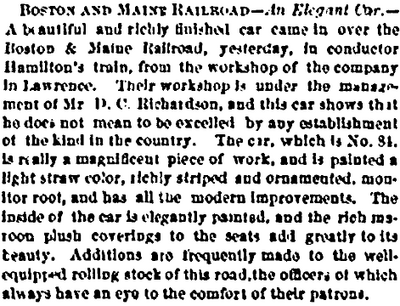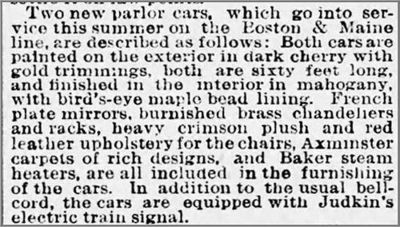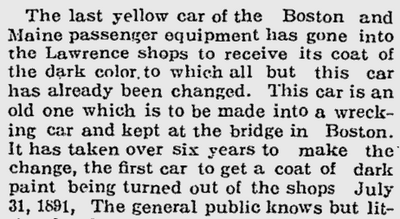Boston & Maine Paint Information
Reference / Historic Railroad Paint Color Index
Locomotives
1905
Train numbers mounted in front of the glass of headlights are painted bright vermillon.
"Discussion, Subject No. 8," Railway Master Mechanic October 1905 p383.
Freight Cars
1890
Box cars painted lead color, or slate, with mineral brown roofs, black ironwork, and yellow block letters. Flat cars and coal cars painted mineral brown.
Portland Daily Press (Portland, ME), 29 July 1890
"Lead Color" was given as being a mix of Keg Lead (white) and lampblack.
The carriage painters' illustrated manual, 1877
1897
All freight cars, except cabooses, refrigerator cars, and line cars, repainted mineral brown (a new shade, slightly darker than the color used previously) with white Roman lettering. Trucks and ironwork also painted mineral brown. Refrigerator cars, cabooses, and line cars continue to have ironwork painted black.
Railroad Car Journal, December 1897
As the result of a boxcar accidentally being lettered "Boston & Mitane," the railroad adopted a new outshopping stencil that identified which paint shop was last to paint each car, using the first three letters of the shop's name (Lawrence, Salem, or Somerville). Stencil was six inches across.
Railroad Car Journal June 1897
Passenger Equipment
1871
Passenger cars painted light straw yellow and "richly striped and ornamented"
The Boston Traveler (Boston, MA), 16 May 1871
1873
B&M Wagner parlor car painted wine and striped in gold leaf.
The Boston Globe (Boston, MA), 9 July 1873
1882
Parlor cars painted dark maroon.
The National Car Builder, August 1882, pg. 89
1884
Parlor cars painted lake with gold ornamentation.
The National Car Builder, July 1884, pg. 81
1885
Passenger car, "Magnolia," assigned to the Eastern Division, painted deep crimson.
The Boston Evening Transcript (Boston, MA), 22 May 1885
Baggage cars of the Eastern Division repainted from a yellow-brown to Tuscan red.
The Portland Daily Press (Portland, ME), 14 February 1885
1886
Two new parlor cars painted dark cherry with gold ornamentation.
The Boston Globe (Boston, MA), 3 June 1886
Passenger cars and baggage cars painted light straw yellow. Interiors finished in mahogany with black walnut trim.
The Portland Daily Press (Portland, ME), 7 September 1886
1890
Baggage cars repainted from Tuscan red to yellow.
The Beverly Citizen (Beverly, MA), 22 November 1890
The Portland Daily Press (Portland, ME), 29 November 1890
1891
Passenger cars assigned to the Eastern and Western divisions begin to be painted dark olive green with gold lettering. Passenger cars assigned to the Lowell division already dark olive green with gold lettering.
The Portland Daily Press (Portland, ME), 26 November 1891
1892
New passenger cars built this year all painted olive green with gold striping.
The Daily Kennebec Journal (Augusta, ME), 10 March 1892
1893
One source claims that B&M passenger cars are painted white giving the railroad the nickname "Ghost Line." This is dubious.
The Pittsburgh Daily Post (Pittsburgh, PA), 24 February 1893
Pullman coaches used on the B&M painted "regulation Pullman Color"
The Portland Daily Press (Portland, ME), 14 September 1893
1897
The last yellow passenger car is repainted "dark," completing a six-year repainting process.
The Lewiston Evening Journal (Lewiston, ME), 2 October 1897
1901
Passenger cars are painted Pullman Color.
The B&M issues an order that all black trim on passenger cars (such as on crown moldings) be eliminated and painted the same color as the body.
Railroad Digest 5 April 1901.
1904
Passenger cars are painted and varnished in "Pullman shade" (dark olive green).
Railway Master Mechanic March 1905 p110.
1905
Interior ceilings of arched-roof passenger cars are painted white. Previous to this change, the ceilings were finished red cherry wood.
Railway Master Mechanic February 1905 p77.
Structures
1905
Metal bridges are sand blasted and painted with Dixon's Silica-Graphite Paint.
"Sand Blasting -- Boston & Maine Railroad," Railway Master Mechanic July 1905 p265.















